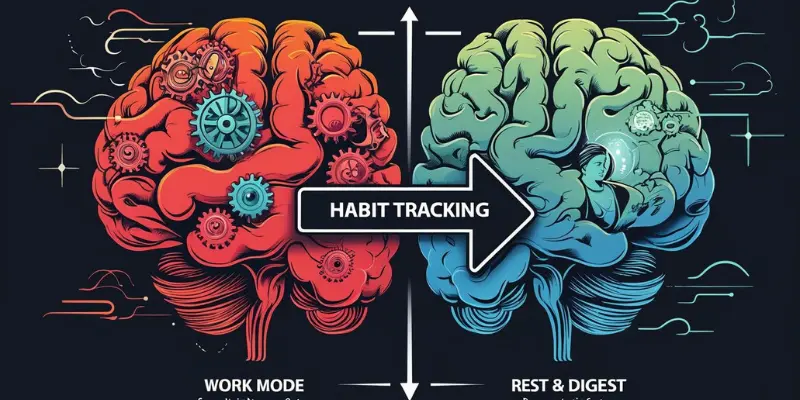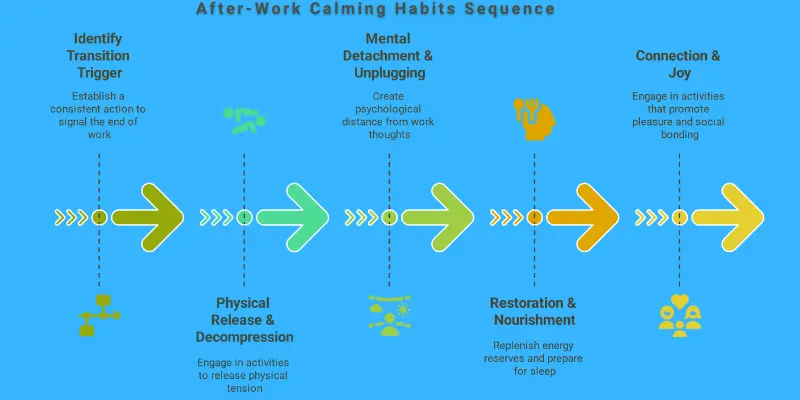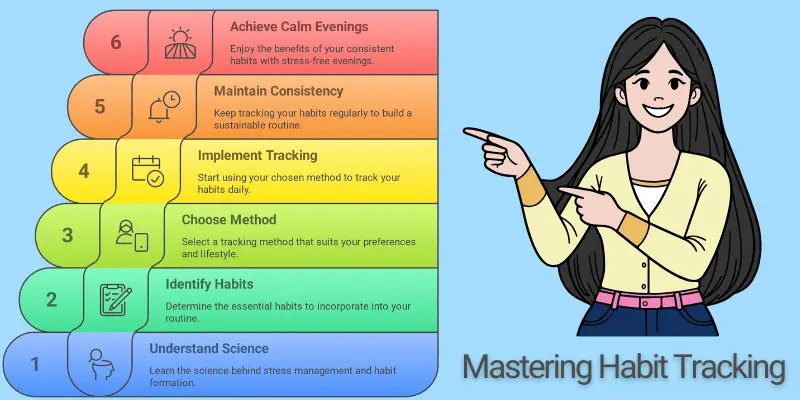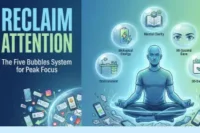Habit Tracking for Stress Management After Work: Your Blueprint to Calm Evenings
Published: 03/07/2025
It’s the end of your workday. You close your laptop, but your mind doesn’t follow. Thoughts about tasks, deadlines, and unanswered emails start spinning in your head. The weight of the day lingers long after you’ve clocked out. Do your evenings feel less like a peaceful unwind and more like an anxious extension of your workday? Are you tired of the constant mental replay, where the stress of the office invades your calm at home?
This post-work stress is more common than you might think, especially in our “always-on” culture. The pressure doesn’t end when you leave the office—often, it follows you home, keeping you on edge. And it’s not just about feeling stressed; this ongoing tension can affect your sleep, relationships, and overall well-being. You might find yourself battling chronic fatigue, irritability, or even sleepless nights, all because you haven’t learned how to transition out of “work mode.” If this resonates with you, know that you’re not alone—and more importantly, there’s a way out.
One powerful tool to combat this cycle is habit tracking for stress management after work. It’s not another checklist to add to your never-ending to-do list, but a simple, empowering solution to help you regain control over your evenings. By tracking your stress-reducing habits, you’ll begin to unwind more effortlessly and reclaim the peace you deserve.
In this comprehensive guide, you’ll uncover the science behind calming habits, discover which stress-busting routines are right for you, and learn how to track your progress with ease. We’ll guide you through a personalized blueprint to transform your after-work hours into moments of peace and relaxation. Unlike other solutions that merely promise calm, this blueprint combines actionable steps with the power of habit tracking to give you sustainable results.
The Science of the “Switch-Off”: Why Your After-Work Routine Matters
We all know the feeling: the laptop closes, but your mind doesn’t follow. It stays “on,” racing with thoughts of tasks, deadlines, and emails. So why is it so hard to truly unwind after a busy workday? The science of stress reveals that your brain needs a deliberate shift from “work mode” to “rest mode” to regain control. Let’s dive into the science behind this transition and discover why your after-work routine matters so much.

The Brain’s Need for Transition
Switching off after work isn’t as simple as closing your laptop. When you’re in “work mode,” your sympathetic nervous system, also known as the “fight or flight” response, is activated. This keeps you alert and ready for action, even when you’re technically done for the day. Without a deliberate transition, your brain remains “on alert,” continuously processing information and staying stressed.
This prolonged state of readiness means stress hormones like cortisol remain elevated, making it difficult for your body to feel relaxed or at ease. To initiate a true “switch-off,” it’s essential to signal safety to your brain, allowing it to switch from the sympathetic nervous system to the parasympathetic nervous system, or the “rest and digest” phase. This is when your body and mind can finally begin to unwind.
Understanding the need for this transition is key—it’s not just about closing your laptop; it’s about creating a mental boundary that helps you leave the stress of the day behind.
The Power of Intentional Habits
The good news is that you can train your brain to switch off by creating intentional habits that foster relaxation. These consistent, deliberate actions help form powerful neural pathways, gradually automating the “unwind” process. Just as you’ve built work habits, you can create after-work habits that signal to your brain that the day is done.
By incorporating predictable routines into your evenings, you reduce decision fatigue—an exhausting mental load that builds after a long day. Knowing exactly what to do to relax, without having to think about it, frees up mental space and reduces anxiety. These habits don’t restrict you; they give you the structure you need to feel in control and truly unwind. When you create these rituals, you give yourself permission to let go of the day’s stress and make space for real relaxation.
The Clarity from Tracking
While establishing habits is crucial, tracking them adds another layer of clarity and self-awareness that enhances your stress management journey. Habit tracking offers invaluable data about what truly works to help you unwind. By keeping track of your daily activities, you can identify patterns in your behavior—what habits leave you feeling calm and what habits might be hindering your relaxation process.
Tracking not only helps you measure progress but also boosts motivation. When you see tangible evidence of your efforts—whether through a chart, checklist, or app—it reinforces positive behavior and keeps you focused on your goal of lasting calm. While many guides offer habit suggestions, few emphasize the power of tracking these habits to optimize your routine. Tracking is a meta-skill—an essential tool that personalizes your journey, helping you tailor your habits for the best results.
Crafting Your Calm: Essential After-Work Habits to Track
Now that we’ve explored the science behind stress and the importance of a clear “switch-off,” it’s time to craft your personalized after-work routine. This section is all about actionable steps—specific habits you can start tracking right away to create your calm. Discover how these habits will not only help you unwind but also build lasting relaxation into your evenings.

The “No One Size Fits All” Principle
When it comes to managing post-work stress, there’s no one-size-fits-all solution. The key is personalization. What works for one person may not work for another, and that’s perfectly okay. The goal is to experiment and explore different habits that align with your unique needs. Take the time to try various techniques, observe what helps you most, and tailor your routine until it feels just right for you. Embrace this self-experimentation as an empowering process that leads to discovering the habits that genuinely help you unwind.
Core Categories of Calming Habits (with actionable, trackable examples)
To effectively manage post-work stress, it’s important to adopt a variety of habits that address different aspects of your well-being. These habits should not only be easy to implement but also tailored to your personal needs. Below, we’ll explore key categories of calming habits that can help you unwind physically, mentally, and emotionally. By tracking them, you’ll gain insight into what truly helps you decompress after a busy workday.
Physical Release & Decompression
Objective: Release built-up physical tension and shift your energy from “work mode” to relaxation.
Examples:
- A 10-minute brisk walk: Take a short walk around your neighborhood or in the park. The fresh air and movement will help clear your mind.
- Simple stretching or light yoga: Stretching is an easy way to release tension stored in your muscles, especially after a day of sitting.
- Deep diaphragmatic breathing: Practice box breathing—inhale for four counts, hold for four, exhale for four, and hold again for four.
- Changing out of work clothes: This symbolic act of shifting into comfortable clothes signals the end of the workday.
Trackable Element: You can track your physical release with checkboxes like “Movement,” “Breathing,” and “Changed Clothes.”
Mental Detachment & Unplugging
Objective: Create psychological distance from work thoughts and disengage from screens.
Examples:
- Digital sunset: Set a time in the evening when you stop using work-related devices (phone, computer, etc.), allowing your brain to disconnect.
- Reading a non-work book: Engage in reading a fiction or non-work-related book to immerse yourself in something enjoyable and unrelated to work.
- Listening to calming music or a non-work podcast: Find music or a podcast that helps shift your focus away from work, easing your mind.
- Journaling: Write a “brain dump” or a gratitude list to release thoughts and emotions from the day.
- Short mindful meditation: A few minutes of focused breathing or mindfulness can help clear your mind.
Trackable Element: Track your unplugging with checkboxes like “Digital Detox,” “Read,” “Journal,” or “Meditate.”
Restoration & Nourishment
Objective: Replenish energy reserves and prepare your body for restorative rest.
Examples:
- Mindful eating: Enjoy a peaceful, screen-free meal where you focus on the taste, texture, and smells of your food.
- Proper hydration: Start your evening by drinking a glass of water to rehydrate after the day.
- Light tidying or planning for tomorrow: A bit of light cleaning or prepping for the next day can help you feel organized and reduce morning stress.
- A warm bath or shower: Soak or shower to ease muscle tension and signal your body that it’s time to wind down.
Trackable Element: Track your restoration with checkboxes like “Mindful Meal,” “Hydrated,” “Prepped for Tomorrow,” or “Warm Soak.”
Connection & Joy
Objective: Engage the parts of your brain associated with pleasure, connection, and social bonding.
Examples:
- Meaningful conversation with loved ones: Spend quality time chatting with your partner, friends, or family, focusing on connecting emotionally.
- Engaging in a personal hobby: Whether it’s drawing, playing an instrument, or gardening, spend time doing something you love.
- Playing a game or doing a puzzle: Enjoy a fun, lighthearted activity that takes your mind off work.
Trackable Element: Track your connection with checkboxes like “Quality Connection,” “Hobby Time,” or “Play.”
Your “Transition Trigger”: The Crucial First Step
One powerful way to help your brain shift from “work mode” to relaxation is by establishing a “transition trigger.” This is a specific, consistent action you take at the end of your workday that signals the shift is happening.
Examples of Transition Triggers:
- Closing your laptop and physically putting it away.
- Changing out of your work clothes into something more comfortable.
- Saying aloud, “Work is done,” or even a simple stretch by the door.
These simple actions immediately initiate the mental and physical shift you need, creating a clear boundary between your work and personal time. This is a crucial step that many overlook, but it’s one of the most effective ways to signal to your brain that the workday has officially ended.
The Blueprint in Action: Mastering Your Habit Tracking System
Now that you’ve learned the science behind stress management and identified the essential habits to incorporate into your routine, it’s time to put your blueprint in action. This section is dedicated to mastering the art of habit tracking—making it simple, effective, and tailored to your life. Let’s explore how to track your habits in a way that truly supports your journey to calm evenings.

Keeping it Simple: The Core Principle of Sustainable Tracking
Habit tracking should never feel like an additional burden; it’s a supportive tool to enhance your self-awareness and monitor progress, not a source of stress. The key is simplicity. Your tracking system must be easy to maintain so that it becomes a natural part of your routine. By keeping it intuitive, you remove any friction that might prevent you from staying consistent. The goal is to make tracking seamless, so you can focus on building sustainable habits that lead to stress-free evenings.
Low-Tech, High-Impact Tracking Methods (Accessible for All)
For many students, a low-tech approach to habit tracking can be the most effective. These methods are simple, easy to use, and provide tangible, immediate results. They help you stay focused on progress without getting overwhelmed by complex technology or apps. Let’s dive into the first method: the classic habit chart.
The Classic Habit Chart
The “Don’t Break the Chain” method, popularized by comedian Jerry Seinfeld, is a simple yet powerful technique for habit tracking. The idea is to create a visible chart where you mark off each day you complete your habit. The goal is to build a streak of continuous habit completion. The satisfaction of seeing your chain grow is incredibly motivating!
A printable habit chart can be as simple as a calendar with checkboxes. You can mark off each day you complete your habit—whether it’s a walk, meditation, or journaling. Seeing those checkmarks accumulate provides a visual cue of your progress, reinforcing positive behavior.
Bullet Journal/Simple Notebook
For those who prefer a more personal, creative approach, a bullet journal is a great option. This flexible system allows you to track your habits with symbols, checkmarks, or simple notes. It’s a quick, customizable, and effective way to stay on top of your routines. A bullet journal offers the added benefit of being screen-free, which aligns with your goal of minimizing screen time after work. This low-tech method offers visual tracking that can reduce stress while giving you a sense of accomplishment each time you complete a habit.
Smart Tech for Seamless Tracking (Leveraging Modern Tools)
If you’re someone who enjoys using technology to stay organized, there are plenty of digital options available. These habit tracking apps not only help you monitor your routines but also offer additional features designed to promote a calm, stress-free evening. Let’s explore some of the best apps that can help you track your habits and maintain balance in your life.
Top Habit Tracking Apps for Stress Management
For those who prefer digital tools, there are several habit tracking apps that are designed to support your stress management goals. These apps go beyond simply tracking habits; they offer unique features that align with your need for a stress-free evening routine.
- Streaks (iOS): This app is known for its simplicity. It sends gentle reminders and lets you customize visuals, helping you build a consistent habit without overwhelming notifications.
- Loop (Android): Ideal for data-driven users, Loop offers in-depth tracking and analysis, giving you insights into your habits over time.
- Habitica: Perfect for those who love gamification, this app turns habit tracking into a game, offering rewards for completing habits and keeping you motivated.
- Notion: This app is incredibly flexible, allowing you to create custom dashboards for habit tracking. It integrates well with other productivity tools, making it easy to organize your routine.
These apps are tailored for stress management, offering features like mood tracking, customizable visuals, and positive reinforcement to help reduce anxiety and keep you motivated.
Smart Integration Tips
Using apps doesn’t have to mean more distractions. Many habit-tracking apps offer features like non-intrusive notifications or widgets that allow for quick logging without becoming overwhelming. You can set gentle reminders that don’t add pressure, and use widgets for seamless tracking that fits effortlessly into your routine.
A growing trend is apps that integrate with mindfulness or sleep-tracking features. This gives you a holistic view of your well-being, allowing you to track not only your habits but also how those habits influence your mental and physical state over time. Combining habit tracking with mood or sleep tracking can provide valuable insights into what works best for you.
Tracking Mindfully: Avoiding the “Perfection Trap”
One of the most important aspects of habit tracking is maintaining a healthy mindset. Tracking is meant to be a tool for awareness and insight, not a cause for self-criticism or guilt. The focus should be on progress, not perfection.
Life happens, and you won’t always check off every box. Missing a day isn’t failure; it’s simply data information that can help you adjust and improve your habits moving forward. The key is consistency over time, not an unbroken streak of perfection.
Remember, the ultimate goal is to enjoy calm evenings, not to achieve a perfect habit tracking chart. So, be kind to yourself and use your data to continuously refine your evening routine without the pressure of perfection.
Sustaining Your Calm: Tips for Long-Term Success
Achieving calm evenings requires more than just starting new habits—it’s about sustaining them over time. In this section, we’ll explore strategies to make your after-work routine a permanent part of your life. By building lasting habits and adopting a flexible mindset, you can ensure that your calm remains consistent and long-lasting.
Start Small, Build Momentum
One of the most effective ways to build lasting habits is to start small. It can be overwhelming to try to change everything at once. Instead, pick just 1-3 simple habits to begin with. Focus on mastering these before gradually adding more. This approach helps you build momentum and prevents burnout. The concept of “Success breeds success” is key—small wins build confidence and motivation, making it easier to tackle bigger changes down the road. Starting with manageable steps creates a solid foundation that you can build on over time.
The Art of Habit Stacking
Habit stacking is a powerful technique that links a new habit to an existing, well-established routine. By doing so, you make it easier to remember and execute the new habit. For example, you might say, “After I brush my teeth, I’ll journal for 5 minutes,” or “After I close my work laptop, I’ll take 3 deep breaths.” This method works because it leverages existing neural pathways—your brain already has the habit of brushing your teeth or finishing work, so it’s easier to stack a new habit on top of these familiar routines. Habit stacking makes the process of integrating new habits feel natural and effortless.
Flexibility and Forgiveness
When it comes to habit formation, self-compassion is essential. Life happens, and missing a day is not the end of your progress. It’s important to remember that habits are about progress, not perfection. If you miss a day, don’t let guilt derail your journey—just get back on track the next day. Practicing flexibility and forgiveness helps prevent frustration and keeps you moving forward. Self-compassion is the key to long-term success; it ensures that you remain motivated and focused on your ultimate goal of calming evenings, without the pressure of perfection.
Review, Reflect, and Refine
Sustaining calm is a dynamic process that requires regular review and reflection. Set aside time for weekly or bi-weekly check-ins to review your habit tracking data. Ask yourself, “What’s working well?”, “What habits feel like a struggle?”, and “What adjustments can I make?” This process of reflection is not about perfection but about continuous improvement. The latest trend in personal development is using data-driven self-improvement without overwhelming yourself. Review your progress, refine your routine, and make the necessary tweaks to your blueprint for an ever-evolving path to calm.
Celebrate Every Win (Big and Small)
Celebrating your progress is essential for sustaining motivation. Acknowledge both big wins and small victories, whether it’s sticking with a new habit for a week or simply completing a challenging task. Positive reinforcement keeps you motivated and reinforces your commitment to your habits. You don’t need grand celebrations—sometimes a simple mental high-five or enjoying a favorite cup of tea is enough to acknowledge your hard work. Celebrating small wins fuels consistency and helps you stay motivated on your journey to calm evenings.
Find Your Accountability (Optional, but Powerful)
While optional, having accountability can be a powerful tool in sustaining habits. Sharing your goals with a supportive partner or friend, joining an online community, or using an app’s built-in community features can provide the external motivation you need to stay committed. Accountability encourages consistency, fosters commitment, and provides a sense of community and support, all of which are essential for long-term success. Whether it’s a friend who checks in on your progress or a community that cheers you on, accountability can make your habit-building journey more enjoyable and rewarding.
Conclusion: Your Evenings, Reclaimed
You now have the blueprint to transform those anxious after-work hours into a sanctuary of calm. By incorporating habit tracking into your routine, you can manage stress more effectively and truly switch off from the demands of work. Imagine turning your evenings into peaceful, rejuvenating moments, free from the mental noise of the workday. With the right habits and a consistent approach, calm evenings are within your reach.
Ready to start your journey to truly calm evenings? Pick just one habit from this guide and begin tracking it tonight. Whether it’s a simple walk, journaling, or a relaxing stretch, taking that first step will set the tone for the rest of your evening. Download a recommended app or simply grab a notebook, and start building your personal blueprint.
What’s the first habit you’re going to track to unwind after work? Share your thoughts in the comments below, and join the community of people reclaiming their evenings, one habit at a time.
FAQs: Your Blueprint to Calm Evenings – Common Questions Answered
Our brains are wired to stay alert to threats and tasks. Without a deliberate signal or routine, your mind keeps replaying work scenarios, making it difficult to transition from “on” to “off.” After-work habits help create this crucial mental boundary.
Habit tracking reduces stress by providing structure and a sense of control. It helps you become aware of what truly helps you unwind, reinforces positive behaviors, and reduces decision fatigue. It’s a tool for self-awareness, not just a checklist.
Effective habits fall into categories like physical release (stretching, short walks), mental detachment (digital detox, reading), restoration (mindful eating, prep for tomorrow), and connection/joy (hobbies, loved ones). The “best” habits are highly personal to you.
The key is to start small – even one simple habit like a 5-minute walk. Tracking doesn’t have to be perfect or complicated. Focus on progress, not perfection, and see it as a supportive tool for self-care, not another chore.
Consistency is more important than speed. While research suggests anywhere from 18 to 254 days for a habit to form, you’ll likely start feeling the benefits of calmer evenings within a few weeks of consistent effort. Be patient and kind to yourself.
Yes! Habit tracking thrives on flexibility. Instead of fixed times, focus on “habit stacking” (linking a new habit to an existing one, like “after I get home, I’ll stretch”). This makes habits adaptable to varied schedules.
A transition trigger is a specific, immediate action you take when work officially ends (e.g., closing your laptop and putting it away, changing clothes). It acts as a clear signal to your brain that the workday is done, helping you mentally switch off.
Neither is inherently “better”; it depends on your preference. Digital apps offer convenience, reminders, and analytics, while manual trackers provide a tactile, screen-free satisfaction. The best tracker is the one you’ll actually use consistently.
Absolutely not! Missing a day is part of the process. It’s not about perfection, but “dynamic consistency.” Just acknowledge it and get back on track the next day. The data still helps you learn and adapt.
Communicate your intention to unwind. Set boundaries together (e.g., “screen-free dinner”). Invite them to join you in calming activities, or find a dedicated quiet space for your personal de-stressing habits. Leading by example can be powerful.
Yes, significantly. By consistently incorporating calming after-work habits, you prepare your mind and body for rest, reducing the mental noise that often interferes with falling asleep and staying asleep. A consistent evening routine is a cornerstone of good sleep hygiene.
Begin by identifying just one simple habit you want to implement consistently after work (e.g., a 5-minute deep breathing exercise). Choose a tracking method that feels easy for you (a simple checkbox on paper or a basic app). Focus on consistency over duration initially.

- Be Respectful
- Stay Relevant
- Stay Positive
- True Feedback
- Encourage Discussion
- Avoid Spamming
- No Fake News
- Don't Copy-Paste
- No Personal Attacks

- Be Respectful
- Stay Relevant
- Stay Positive
- True Feedback
- Encourage Discussion
- Avoid Spamming
- No Fake News
- Don't Copy-Paste
- No Personal Attacks



